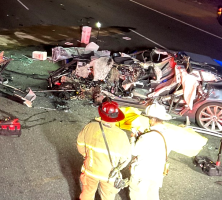
—
A Tesla Autopilot crash lawsuit alleges Giovanni Mendoza Martinez, 31, was killed due to Tesla and Elon Musk making false claims about the Model S car that slammed into the side of a ladder fire truck.
In February 2023 at about 4 a.m., Giovanni was driving his 2014 Tesla Model S on Interstate 680 in California, a car which he believed “would drive itself and he no longer needed to drive it.”
Due to a previous crash, the highway was blocked by a large ladder fire truck parked diagonally across two lanes of traffic with several other parked emergency vehicles, all with their emergency flashing lights activated.
The Model S was traveling about 70 mph when it slammed head-on into the side of the fire truck, killing Giovanni who had engaged Autopilot about 12 minutes before the crash.
His family filed a wrongful death lawsuit blaming Tesla for his death and the crash. But Tesla argues the Model S owner’s manual emphasizes a driver must be aware of their surroundings and keep their hands on the steering wheel.
Telsa also notes how a driver is provided warnings when Autopilot is activated and Giovanni would have received repeated warnings if his hands were not on the steering wheel for specific periods of time.
The lawsuit also doesn’t explain how the driver or his passenger (his brother) failed to see all the emergency vehicles with flashing lights blocking the highway.
Tesla filed a motion for judgment on the pleadings regarding misrepresentation and concealment claims, arguing it wasn’t to blame for a driver who allowed his car to smash into a fire truck at 70 mph.
Even the lawsuit admits Giovanni was not in control of the Tesla.
“At the time of the collision, Giovanni was not controlling the Subject Vehicle, but he was instead passively sitting in the driver’s seat with the ‘Autopilot’ feature engaged.” — Tesla Autopilot crash lawsuit
Tesla told the judge the subject car that crashed into the fire truck was a 2014 Model S, but the lawsuit continually makes allegations about technology related to vehicles manufactured after 2014.
And according to Tesla, the plaintiffs make allegations about future events, and most of the Autopilot lawsuit is hearsay about incidents involving other Tesla drivers and vehicles which have nothing to do with this case.
Tesla Autopilot Crash — Concealment
Judge Vince Chhabria granted Tesla’s motion to dismiss a concealment claim because the plaintiffs failed to adequately claim Tesla had a “duty to disclose material information” to Giovanni.
Tesla Autopilot Crash — Misrepresentation
The plaintiffs had better success regarding misrepresentation claims as Judge Vince Chhabria ruled the lawsuit adequately “alleges both actionable misrepresentations and reliance on at least one of those misrepresentations.” That one thing is the name, Autopilot.
“The ‘Autopilot’ name is plausibly misleading, especially in light of the complaint’s allegations that Tesla employees expressed concern that it was and that German regulators requested it be changed to something less so.” — Judge Chhabria
According to the judge, the Autopilot name is not the kind of “implied assertion” that can’t support a misrepresentation claim because it is alleged to be affirmatively misleading, “not a statement that is misleading by omission.”
The Autopilot lawsuit also references statements from Elon Musk that Autopilot was “probably better” than a human driver and autonomous driving was “basically a solved problem.”
The judge acknowledges the statements were made in 2016 and Giovanni was driving a 2014 model, but “the statements are still plausibly misleading given the ability of the cars to receive software updates over the air.”
Judge Chhabria says “predictions as to future events cannot normally form the basis of a fraud action,” but predictions made by Musk about advances in self-driving technology are legally actionable.
The Tesla Autopilot fire truck crash lawsuit was filed in the U.S. District Court for the Northern District of California: Mendoza, et al., v. Tesla, Inc.
The plaintiffs are represented by Singleton Schreiber, LLP.

